| Pages:
1
2 |
garage chemist
chemical wizard
    
Posts: 1803
Registered: 16-8-2004
Location: Germany
Member Is Offline
Mood: No Mood
|
|
Compressor cooling for the home lab
Here's a new gadget I have built.
As I've used resistance wire in the past to build a furnace and carried out reactions at temperatures above 1000°C in it, I thought that I have to
master the other end of the temperature scale as well.
I was inspired to build this as I came across forums like http://www.extremecooling.de/forum/forum.php and http://www.xtremesystems.org/forums/forumdisplay.php?f=80
where people have built some very impressive cooling systems, even cascades, to overclock their computers to the max at CPU temperatures far below
freezing.
Why is it that nothing comparable has been documented by amateur chemists, when such systems are potentially very useful in the lab? I find that this
is a bit of a shame, and I wanted to change this.
So here is my first single-stage immersion cooler.
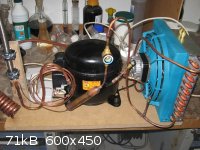
The condenser (on the right) is a 0,72kW Rivacold model (somewhat oversized for this application) with variable speed fan.
From the outlet of the condenser, the liquid line goes up to the sight glass, through the filter drier which is filled with 30g 3A molecular sieve and
to the capillary tube (0,8mm ID, 380cm long) which serves as the expansion device.
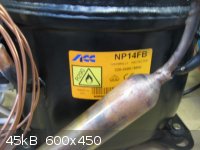
The compressor is a brand new NP14FB from Cubigel (formerly ACC). It is designed to run with the refrigerant I'm using and carries the appropriate
warning label.
The reason why I got this one and not a cheaper Danfoss compressor is that the Cubigel R290 compressors use mineral oil while Danfoss uses POE (polyol
ester) oil even for their R290 compressor series. POE oil turns acidic upon exposure to atmospheric moisture while mineral oil is unproblematic in
this regard. Thus my decision for a Cubigel compressor.
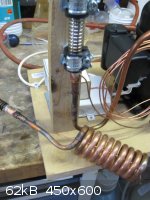
The evaporator is a coil of 8mm OD copper tubing. It is connected to the setup via a length of flexible stainless steel suction line. The capillary
tube also runs through this suction line, giving some heat exchange between the cold suction gas from the evaporator and the pressurized liquid
refrigerant.
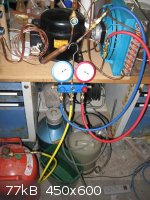
The setup for charging the system with refrigerant "R290bbq"
from the tank (the adaptor is selfmade, you can't buy this anywhere), and measuring the suction and condensing pressure.
Prior to charging, the system was evacuated with a two-stage rotary vane pump according to good practice.
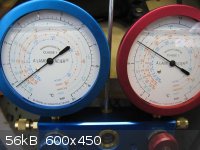
The pressures during operation: -0,2 bar suction pressure, 8 bar condensing pressure. Lowering the fan speed increases the condensing pressure and
thus the pressure difference across the capillary tube, leading to higher refrigerant mass flow and more cooling capacity.
Higher fan speed leads to the opposite, but also lower suction pressure and thus lower achievable temperatures.
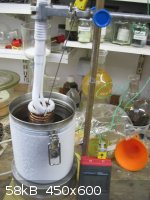
The system cools an uninsulated metal container with 1kg ethanol, magnetically stirred, down to less than -40°C in about 30 minutes.
This is low enough to condense anhydrous ammonia in a flask immersed in this bath.
[Edited on 29-4-2011 by garage chemist]
|
|
|
woelen
Super Administrator
        
Posts: 7976
Registered: 20-8-2005
Location: Netherlands
Member Is Offline
Mood: interested
|
|
Your home-built apparatus is amazing. I also have been thinking of making a cooling device, but the size of all the equipment holds me back (I have
limited space and don't want to cram my lab with bulky devices, it is quite full already). A more compact form of cooling is the use of layered
Peltier elements, but the cooling capacity of these devices is too low for practical use in chemistry. You can reach low temperatures with these (well
below -30 C), but as soon as a small somewhat exothermic reaction is carried out in these, then the temperature quickly rises again.
I purchased sulfamic acid and made 50 ml of fuming nitric acid with the intent of making potasium dinitramide, KN(NO2)2, but the whole experiment
requires temperatures of -35 C or so and I still do not have the right cooling equipment to do this experiment. So, these chemicals I still have
around, unused. When the kids grow older and leave the house, then I certainly hope to have more space, but this is something which certainly is well
over 5 years in the future, possibly more.
|
|
|
Magpie
lab constructor
    
Posts: 5939
Registered: 1-11-2003
Location: USA
Member Is Offline
Mood: Chemistry: the subtle science.
|
|
Very nice GC. Does this device give you temperatures significantly lower than commercially available small freezers? I have a large food freezer and
just measured it at -15C.
The single most important condition for a successful synthesis is good mixing - Nicodem
|
|
|
garage chemist
chemical wizard
    
Posts: 1803
Registered: 16-8-2004
Location: Germany
Member Is Offline
Mood: No Mood
|
|
Yes, it reaches -40°C without problems, as I wrote. Trying to get lower temperatures than that with a single-stage unit quickly becomes uneconomic,
though one can use lower-boiling refrigerants like R507 or R404a. R1270 (propylene) would also be a very good refrigerant to fill into this system
instead of propane in order to reach lower temperatures.
|
|
|
Sedit
International Hazard
    
Posts: 1939
Registered: 23-11-2008
Member Is Offline
Mood: Manic Expressive
|
|
GC, if you attach the photos and then go back and edit your post you will see brackets with the file name in it, move these to the area of the post
you wish them to show up at.
Im so glad your posting this, I have an old air conditioner outside and have been considering the same exact thing recently. I considered using
Acetone as the bath. Given the amount of ice around the bath perhaps you would do good to wrap it in styrofoam to stop heat transfer to it.
[Edited on 29-4-2011 by Sedit]
Knowledge is useless to useless people...
"I see a lot of patterns in our behavior as a nation that parallel a lot of other historical processes. The fall of Rome, the fall of Germany — the
fall of the ruling country, the people who think they can do whatever they want without anybody else's consent. I've seen this story
before."~Maynard James Keenan
|
|
|
ziqquratu
Hazard to Others
  
Posts: 385
Registered: 15-11-2002
Member Is Offline
Mood: No Mood
|
|
You don't want to use polystyrene insulation with acetone... it'll dissolve when you (inevitably) splash some solvent on it. It's fine with alcohols
(MeOH or EtOH - methylated spirits works perfectly).
You could also wrap it in some other insulation (cotton wool or fibreglass are simple and effective - works best by putting your bath inside a larger
container, packing the space between them with your insulation. Alternatively, if you want an effective permanent solution, use vermiculite as the
insulation and seal the gap between bath and outer container with bathroom silicone sealane - it's resistant to most common cold-bath solvents,
including acetone in my experience, but make sure you leave no holes in the seal or the solvent will cause the vermiculite to collapse).
[Edited on 29-4-2011 by ziqquratu]
|
|
|
garage chemist
chemical wizard
    
Posts: 1803
Registered: 16-8-2004
Location: Germany
Member Is Offline
Mood: No Mood
|
|
Quote: Originally posted by Sedit  | GC, if you attach the photos and then go back and edit your post you will see brackets with the file name in it, move these to the area of the post
you wish them to show up at.
|
I did this, but only clickable links to the pictures show up, not the pictures themselves as I want.
For insulation of the ethanol bath, I will try to coat a plastic dish with polyurethane foam. Magnetic stirring of the bath is absolutely essential,
without it the cold liquid will just collect at the bottom of the bath and the middle and upper layers of the ethanol will stay warm.
Water with antifreeze (ethylene glycol) is no good as a bath fluid, it becomes far too viscous at temperatures below -20°C.
Heat transfer from the evaporator to the bath is very slow despite stirring and it takes forever to get really cold.
Ethanol is good, methanol would be even better as it tolerates up to 40% water content (think of all the moisture condensing into the bath) before its
freezing point increases above -60°C.
[Edited on 29-4-2011 by garage chemist]
|
|
|
woelen
Super Administrator
        
Posts: 7976
Registered: 20-8-2005
Location: Netherlands
Member Is Offline
Mood: interested
|
|
Just a tryout to make one of the pictures visible in the text:
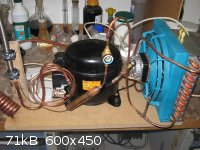
Here, the picture is uploaded, using the attachment button at the bottom of the link. I just browsed the location of the picture and used the upload
button. Nothing special I have done.
And here is a link to another picture, this is a deeplink to a picture on an external resource (one of my webpages):

This uses the [ img ] and [ /img ] tags.
Both mechanisms work without problem. How did you do the upload in your first post? I think that you did not a simple upload but something special.
=============================================================
Good to read that you can easily reach -40 C in an economic way and that there even is some headroom to go even lower. I also like the idea very much
of using a cooling bath of ethanol or methanol instead of putting the flask just in air. I really envy you that you have such equipment at hand. I
have so many experiments which require low temperatures, I simply cannot do them, at least not for the next few years.
[Edited on 29-4-11 by woelen]
|
|
|
garage chemist
chemical wizard
    
Posts: 1803
Registered: 16-8-2004
Location: Germany
Member Is Offline
Mood: No Mood
|
|
Finally, the pictures are showing up as I like. I had to delete and re-upload them. No idea what went wrong the first time.
|
|
|
Jor
National Hazard
   
Posts: 950
Registered: 21-11-2007
Member Is Offline
Mood: No Mood
|
|
Very nice GC! This really opens up a new world of experiments such as reactions in liquid ammonia!
I always like to see pictures of the things you make. Now I realise I have never actually seen pictures of your lab as a whole, or better a lab tour
 I really wonder how your lab looks where you do all this stuff! I really wonder how your lab looks where you do all this stuff!
http://www.sciencemadness.org/talk/viewthread.php?tid=4777
Maybe if you have the time ? 
|
|
|
garage chemist
chemical wizard
    
Posts: 1803
Registered: 16-8-2004
Location: Germany
Member Is Offline
Mood: No Mood
|
|
Perhaps I will one day post full pictures of my lab, but I'm not yet sure whether this is a good idea.
From the pictures in my documented experiments, you can already see quite well how my lab space looks like.
Yes woelen, one common issue with the usual refrigeration equipment is the bulkiness and weight.
The compressor on this immersion cooler already weighs 14kg.
I also have a cryostat, a very old piece of equipment with a 5L bath that can be cooled down to -60°C. It is about 1 meter tall and 60 by 60cm wide,
weighing 66kg. You can see it in the "storage of pressurized liquid SO2" thread.
The disdavantage of this is that it cannot be used under the fume hood, so working with toxic liquefied gases requires good ventilation and special
attention.
My homebuilt immersion cooler can be operated on the workbench next to the fumehood, and the evaporator used inside the fumehood.
Immersion coolers are also available as commercial units by e.g. Lauda:
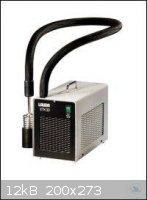
from Windaus
but these are always more than EUR 2000 when new.
The parts for my selfbuilt cooler were only around EUR 300 in total, including the new compressor (EUR 160).
However, together with the necessary special tooling (refrigeration manifold with valves, manometers and refrigerant charging lines, quick disconnect
couplers, and other stuff), I had to spend a total of about EUR 600 to build this unit. I already had the propane-oxygen burner assembly and gas tanks
required for brazing the copper tubes and had previously learned how to braze, otherwise I would not have started this project.
Sedit, what kind of compressor is inside your old air conditioner, and what refrigerant does it run on? I would gladly help you design a laboratory
cooler if you can post detailed information about the compressor.
Here is a very good video from Danfoss about how hermetically sealed reciprocating compressors are built:
<iframe sandbox width="425" height="349" src="http://www.youtube.com/embed/bAZGkny8g64" frameborder="0" allowfullscreen></iframe>
My compressor is built like this, and this type of compressor is used in virtually all household fridges and freezers.
However, air conditioners often have a different, more powerful type of compressor, for example a rotary.
[Edited on 29-4-2011 by garage chemist]
|
|
|
GreenD
National Hazard
   
Posts: 623
Registered: 30-3-2011
Member Is Offline
Mood: Not really high anymore
|
|
VERY cool! Nicely done.
Begs the question though - ... peltier coolers?
|
|
|
beergod
Harmless

Posts: 23
Registered: 19-2-2011
Member Is Offline
Mood: No Mood
|
|
Is there any reason you couldn't do this with an old AC unit? Get a decent sized one, pull out the rotary vane pump and condenser/fan, make an
evaporator and then link it all together? When re-soldering the copper is there a standard refrigerant fill valve you could put on there so your
local AC guy can fill it for you?
|
|
|
watson.fawkes
International Hazard
    
Posts: 2793
Registered: 16-8-2008
Member Is Offline
Mood: No Mood
|
|
Quote: Originally posted by beergod  | | When re-soldering the copper is there a standard refrigerant fill valve you could put on there so your local AC guy can fill it for you?
|
Refrigerant valves (at least in the USA) use Schrader valves. There's the same form as standard automotive
tire valves, although the ones for refrigerant seem to be better constructed: better tolerances, better elastomers. You can get them either with
copper tubing tails for soldering or pipe threads.
To make your technician happy, put in three: high side, cold side, and fill. They use the other two for checking pressuring and verifying that they've
put in the right amount of refrigerant.
|
|
|
smuv
National Hazard
   
Posts: 842
Registered: 2-5-2007
Member Is Offline
Mood: Jingoistic
|
|
ugh, I am jealous! I have been considering doing this for quite some time. Excellent work, I am interested to see how you do with propylene or maybe
a cascade w/ ethylene  . .
"Titanium tetrachloride…You sly temptress." --Walter Bishop
|
|
|
smaerd
International Hazard
    
Posts: 1262
Registered: 23-1-2010
Member Is Offline
Mood: hmm...
|
|
Now that is impressive! Excellent work!
Good thing I found this before starting a thread. I had an idea of harvesting a fridge compressor and trying to bend the lines to coil around the
inside of a liebig condenser and cap and fill it with mineral oil or something similar. Not to de-rail the thread because its obviously a bad design.
Though what you've done here is great!
|
|
|
peach
Bon Vivant
    
Posts: 1428
Registered: 14-11-2008
Member Is Offline
Mood: No Mood
|
|
Nice one GC!
This is something I've been messing around with a lot recently but, lacking the money for the gauges and tanks, tried to avoid using compressors by
looking at frigorific mixture and so on.
Do you have a variac handy GC? Can you spool the rpms of the compressor? You know what I'm thinking. 
Magpie your freezer should reach about -30C if you engage the super freeze and leave it to stand for a while. It may take a while to drop. The super
freeze button is essentially a short across the thermostat, so the pump runs continuously. A normal laboratory freezer gets that cold. The only
difference between it and a normal domestic freezer is the lock on the door and that some of them use digital controls rather than a bimetallic strip
(you can buy a basic PID from China for about £20 to replace that if you want). The bimetallic strips allow the temperature to drift up and down by
about 5 degrees before switching.
Oh... and the price. £500.
Green D, peltier coolers don't work unless you have literally kilowatts worth of them. I spent a long while messing around with it in the kitchen with
bench supplies and elements rated at 139W or something like that. Sometimes using multiples of them in parallel or stacked. They produce a ton of heat
from their own resistance once running. The delta T quoter is also difficult to obtain, I got something closer to 40 out of them when actually running
continuously. Solid state coolers do exist, but they need quite big heat sinks I believe. But to give you an idea, I tried placing three of these
hundred watt plus ones on a heatsink sat in a puddle of water, in a small plastic tube. Then another heatsink on the other side with a fan removing
the heat. Even after hours of them eating up hundreds of watts, the water had barely cooled, let alone frozen. Buying kilowatts worth of TECs isn't
too expensive. But the power supply would be if you weren't using a surplus heavy duty transformer. A microwave oven rewound might be okay. Or a 110v
site transformer if they're in series and high voltage versions. Or even chopping it directly from the mains with high voltage elements (pretty
dangerous).
The Chinese sell TECs very cheaply. I've tried quizzing western suppliers over were theirs were coming from, given that they cost multiples more and
the figures from the Chinese ones are close to their own; on paper and in practice. No reply.
My plan since that was to pick up a chest freezer, or even a normal one, from the tip, add a liner, bucket, silicone or otherwise make it capable of
holding water and to then chuck in lots of bottles filled with a salt ice / glycol mix that freezes around -30C. The latent heat required to melt the
ice is really high. I'd then fill the remaining space with -50C gylcol mix.
The largest flasks most people have are around 2l, so 1l capacity for distillation. Water requires around 334 kj/l to melt. Diethyl ether's enthalpy
of vapourisation is around 332 kj/l at it's atmospheric BP. So even tens of litres of ice in bottles is an order of magnitude more than is
theoretically needed to change the temperature of the coolant at all.
I also considered the possibility of using TEC elements inside such a freezer to drop it by another 30 or so towards dry ice, for only a few pounds
worth of investment.
Both compressor based pumps and TECs loose pumping power as the temperature differential increases, having zero at their maximum differential. So the
idea was to not bother too much with that, but rely instead on the state changes. Hence, a single TEC element may be enough provided you don't do dry
ice experiments on a daily basis. With a pump in the bottom, the glycol would circulate to your regular glass jackets. Dilute sulphuric acid also
freezes at a very low temperature I'm lead to believe.
I agree with your point GC, having just literally bought a tube furnace yesterday, that the cold end of the spectrum is something that's harder to get
around than the hot (unless you mean quartz and Moly elements hot). This ties in well with the window AC condenser anomonous posted a while ago.
I've just given the garage a semi-decent clear out, so I may begin experimenting on the -30C latent chest cooler by bring some new junk into it. The
parts should be something like plastic bottles / antifreeze / pond pump / bin? / silicone sealant? Should in theory hold -30C for a good long while as
even the single sized freezers contain around a hundred litres of volume. It's also power fault proof due to the thermal momentum of the solid. The
tip has stacks of spare freezers for free.
I was putting off doing it but, having seen this, you've spurred me on to hurry up and give it a go.
I've also been reading around cryocoolers, pulse tubes and other odd forms of reaching cryogenic temperatures. MIT have developed a superconducting
version of the TEC, on a microscopic scale. Because it uses superconduction, the heat can't 'drift' between the sides because the carriers are blocked
by quantum probabilities and the superconduction means no heat is generated by internal resistance. It can achieve something not far off absolute
zero, with zero moving parts. Very impressive stuff. Stick some SQUID elements on there and you have an implantable neural probe with a higher
resolution than a normal MEG scanner, due to the closer proximity of the field sources.
No pictures of the chest condenser since it's not done yet, but here's some of yesterday's bounty sat in the kitchen late last night; in need of a
paint job. And yes, that German guy with the 5 stage cascade is good. 




[Edited on 27-5-2011 by peach]
|
|
|
Wizzard
Hazard to Others
  
Posts: 337
Registered: 22-3-2010
Member Is Offline
Mood: No Mood
|
|
Here's some pictures of what my friend Ivan has been working on- His site is www.periodictable.ru


[Edited on 5-27-2011 by Wizzard]
|
|
|
peach
Bon Vivant
    
Posts: 1428
Registered: 14-11-2008
Member Is Offline
Mood: No Mood
|
|
Cryocooling and liquefaction of N2?
Если ваш друг может
получить cryocoolers в России,
дайте мне знать. 
Nice tiling job on the workbench. 
That dewar needs the moisture and oxygen removing from it. Did he fill it with N2 from a cylinder? The hoses seem to be full of coolant.
[Edited on 27-5-2011 by peach]
|
|
|
garage chemist
chemical wizard
    
Posts: 1803
Registered: 16-8-2004
Location: Germany
Member Is Offline
Mood: No Mood
|
|
Peach, what kind of heating elements are in that tube furnace? With a temperature rating of 1450°C I would guess silicon carbide.
I think you know how valuable such a furnace is, and that SiC heating elements have a regrettably short lifespan compared with MoSi2 ones.
At 1450°C, carbothermic phosphorus production starts to become feasible. Perhaps you can do some experiments for our curiosity?
For changing the rpm of the compressor, I would need a variable frequency drive. I don't have the money for that, and the usefulness would be very
limited anyway- below a certain frequency the rotor will simply stop, and the windings tend to overheat at frequencies much below 50Hz anyway.
Changing the evaporating temperature and cooling capacity of this system could be done by having several capillary tubes of different length switched
in parallel by solenoid valves when desired.
What kind of Cryocooler is that, Wizzard? How does it work?
I never seriously considered Peltier elements alone for lab cooling- they are very inefficient compared with compressor cooling and incapable of
maintaining large temperature differences.
The only application that I can see is to augment a compressor cooling system: cool the hot side of a Peltier element to -40°C with a single-stage
compressor system, and the cold side should be able to reach -60°C with ease. This would be significantly cheaper than a two-stage compressor system.
[Edited on 27-5-2011 by garage chemist]
|
|
|
warteo
Harmless

Posts: 42
Registered: 30-3-2011
Location: Oz
Member Is Offline
Mood: No Mood
|
|
Some really nice work there Garage Chemist!
Along the same lines, I found the following yesterday which interested me greatly:
http://citizensciencequarterly.com/2011/05/10/liquid-nitroge...
|
|
|
garage chemist
chemical wizard
    
Posts: 1803
Registered: 16-8-2004
Location: Germany
Member Is Offline
Mood: No Mood
|
|
Why does he use an expensive membrane separator to produce nitrogen from air? This detail struck me as silly and unnecessary in that article.
Liquid air is just a tiny bit less cold than LN2, the difference is barely noticeable.
I think the only treatment that the supplied air needs is rigorous drying and removal of CO2.
|
|
|
peach
Bon Vivant
    
Posts: 1428
Registered: 14-11-2008
Member Is Offline
Mood: No Mood
|
|
@Warteo
Yep, the LN2 generator has been around for a while and can be found on many sites, there's even a youtube video of it. Wizzard is showing something
similar above.
If a keen engineer could do even a half decent job of recreating a cryocooler at a more reasonable price, that'd be a big deal. Building tiny Stirling
engines is practically a disease among machinists, and that's basically all a crycocooler is. It's just that 99.9999%+ of the population has no idea
what they are or any use for them.
@GC
I think they're silicon carbides. The furnace is old, but the elements don't look too bad. If you check out I Squared R's pdf's, they mention that a
protective coat of silicone dioxide forms on the elements at high temperatures. It's still reaching 1600C with the dial only being 2/3rds or so up.
The thermocouple is an S type (platinum / rhodium).
Conversely;
| Quote: | | Moly-D should not be used between the temperature range of 400 and 700oC (752-1292oF), where a destructive low temperature oxidation may occur called
pest. |
- I Squared R
Would a variac not work for controlling the pump's RPMs provided it was running continuously? It'd have to start at full voltage to overcome stiction.
I suspect you are correct that at some point it is going to stall under friction, but it may be worth someone with a variac and pump giving it a go to
see at what voltage it drops out into humming.
How about using a needle valve in the loop to restrict the flow?
I am interested in this mention you make of cooling the loop with a TEC, it seems like it'd be easier than putting it inside the freezer it's self. I
have a bunch of the things, a variable 25 amp bench supply and heat sinks sitting around so all I need is some simple way of connecting it to the loop
and I can give it a go (A block of aluminium drilled to the pipe ID and sawn open to create a split block? I'm thinking that's the way to go).
I don't know how it is in Germany, but in the UK it is technically illegal for me to take anything from the tip. And I have taken (recycled  ) a lot, and they are watching and there are CCTV cameras down there. I've been down
once or twice since seeing this thread to have a look for a semi-decent chest freezer but the only ones so far are really beaten up (lids snapped off
etc). ) a lot, and they are watching and there are CCTV cameras down there. I've been down
once or twice since seeing this thread to have a look for a semi-decent chest freezer but the only ones so far are really beaten up (lids snapped off
etc).
The guy with the LN2 generator is using a membrane to remove water and oxygen from the gas he's feeding it. Water would create problems dropping the
temperature and the oxygen in the feed would form LOX, which would be a fire issue. CO2 is a much more minor component of the atmosphere by
comparison.
I'll have a look into phosphorus, it is something I'm interested in; along with CS2, ketene, SO3, AlCl3 and so on. I'm emailing people about a Quartz
liner right at this moment (take your guesses on the price, because they're about to quote it  and I'm scared). and I'm scared).
Why do you and the others use Kanthal over Nichrome? Both of them seem to have the same service temperature and issues.
Without further a due, here are some more photos to keep the forum pretty to look at (seems as though the guy had advertised it with the wrong
temperature in it's description);
It's gettin' hot in here... so take off all your clothes... I am... gettin'... so hot...


[Edited on 31-5-2011 by peach]
|
|
|
garage chemist
chemical wizard
    
Posts: 1803
Registered: 16-8-2004
Location: Germany
Member Is Offline
Mood: No Mood
|
|
For controlling the rpm of a hermetic compressor, you need to control the frequency, not voltage, and that is done with a VFD, a quite expensive and
elaborate piece of power electronics. You try connecting a fridge compressor to a variac and tell me what happens.
And increasing the rpm past its rated value would be a very bad idea for my device. The compressor is already running very close to the maximum
allowable casing and discharge temperatures at 230V and 50Hz.
I have a much better idea of controlling the mass flow, evaporating temperature and cooling power of my cooler that I am soon going to try.
First I will shorten the capillary tube sufficiently to give an evaporating temperature of -10 to -15°C (3,5- 3 bar abs. evaporating pressure) which
will increase the cooling power from 150 to a solid 800 watts, vastly shortening the cooldown time from ambient for large bath sizes.
Between the capillary tube and filter drier I will install a solenoid valve that will be driven by a pulse-width modulated signal with a cycle
frequency of 1 or 2 seconds.
Since the casing of the compressor is connected to suction, it acts as a buffer volume, smoothing out the pressure swings and giving a mean effective
evaporating pressure with the pulsed mass flow.
By choosing a sufficiently short "on" time for the PWM (like 0,2s on and 0,8s off) I can reduce mass flow and evap pressure enough to reach my desired
-40°C.
Eventually an electronic regulator will be built that cools down
the bath at maximum cooling power and starts pulsing the valve when the temperature reaches -10°C in order to lower the temperature further.
If you are after compressors, I suggest opening a topic and/or PMing members at the Xtremesystems forum and asking to buy used ones.
This is what I did at a german forum. Over the next weeks, several rotary air-conditioning compressors and maybe even one of those large blue Maneurop
compressors may find their way to me. 
|
|
|
peach
Bon Vivant
    
Posts: 1428
Registered: 14-11-2008
Member Is Offline
Mood: No Mood
|
|
I like the solenoid idea. Surely that'd need quite a good solenoid however? How about the ones in boilers for controlling the natural gas flow? Those
switch are hundreds of times per day for years. Although I think the gas mains runs on about 3 bar, rather than 30 plus a fridge / freezer compressor
can manage.
I think for simplicity I'd have tried a needle valve if I could easily open and recharge loops, but having some form of electronic feedback and
control is certainly useful! It took years for me to install the datalogging software for my pH / temp meter and now it's so cool! I can walk away
from things for hours and still show precisely what has happened better than if I stood next to it all day.
As far as the variac goes, I don't even own a variac! 
[Edited on 1-6-2011 by peach]
|
|
|
| Pages:
1
2 |